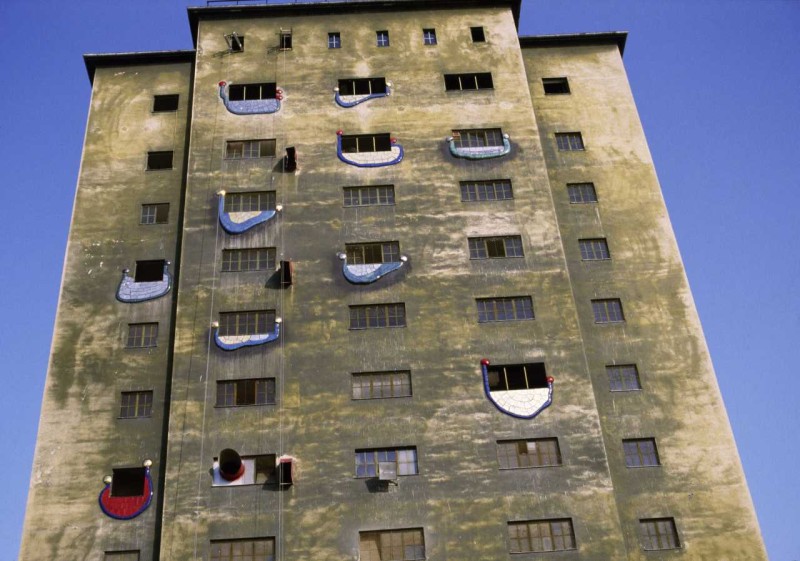Facade design with tree tenants
Work on site, suggestions for improvements, tape recording, May 13, 1983
The first thing a person arriving in Krems from Vienna notices is the 197-ft. granary of 1938 in the harbour area. As protection from air raidas the silo was painted in a dirty-brown camouflage paint during the Second World War. In 1981 the owner, Hubert Mierka, approached Hundertwasser with the suggestion of beautifying the silo. With the redesigned granary, Hundertwasser wanted to create a beautiful gateway to the Wachau. Good, durable material was to be used: ceramics, gold and silver. Tree-tenants were to be installed and the canopies planted with greenery. The drab, sterile silhouette was to be enlivened with onion domes. Moreover, Hundertwasser had the idea of having a mosaic or ceramic spiral go all the way around the building. The entire extent of Hundertwasser`s concept was never realised. The builder used only a few of the proposed measures.
mehr weniger- Das Hundertwasser Haus, Vienna, 1985, p. 143 - 145 (and c)
- H. Rand, Hundertwasser, Cologne, 1991, p. 204/205 (c) and ed. 1993, p. 176/177 (c)
- Hundertwasser Architektur, Cologne, 1996, p. 126 - 127 (c9, 312 (c) and ed. 2006, pp. 100-103 (and c), 303 (c), 312
- R. Schediwy, Hundertwassers Häuser, Vienna, 1999, p. 240
- A. C. Fürst, Hundertwasser 1928-2000, Catalogue Raisonné, Cologne, 2002, Vol. II, pp. 1212/1213 (and c)
- IDEA Designcenter, Schrems, 2001 (detail, c)
- Hundertwasser, The Green City, Sejong Museum of Art, Seoul, 2016, pp. 174 (and c), 258
- Bunte, no. 10, Feb. 28, 1985, Munich, p. 152 (c)
- wind, world interior design, nr. 28, 1994, Tokyo, p. 7 (c)
- Unser Waldviertel, no. 3, 2000, Schrems, p. 13 (detail, c)
- Wingspan, no. 386, August, 2001, Tokyo, p. 42 (detail, c)
- Calendar: Hundertwasser Architektur 2007, teNeues, Kempen
